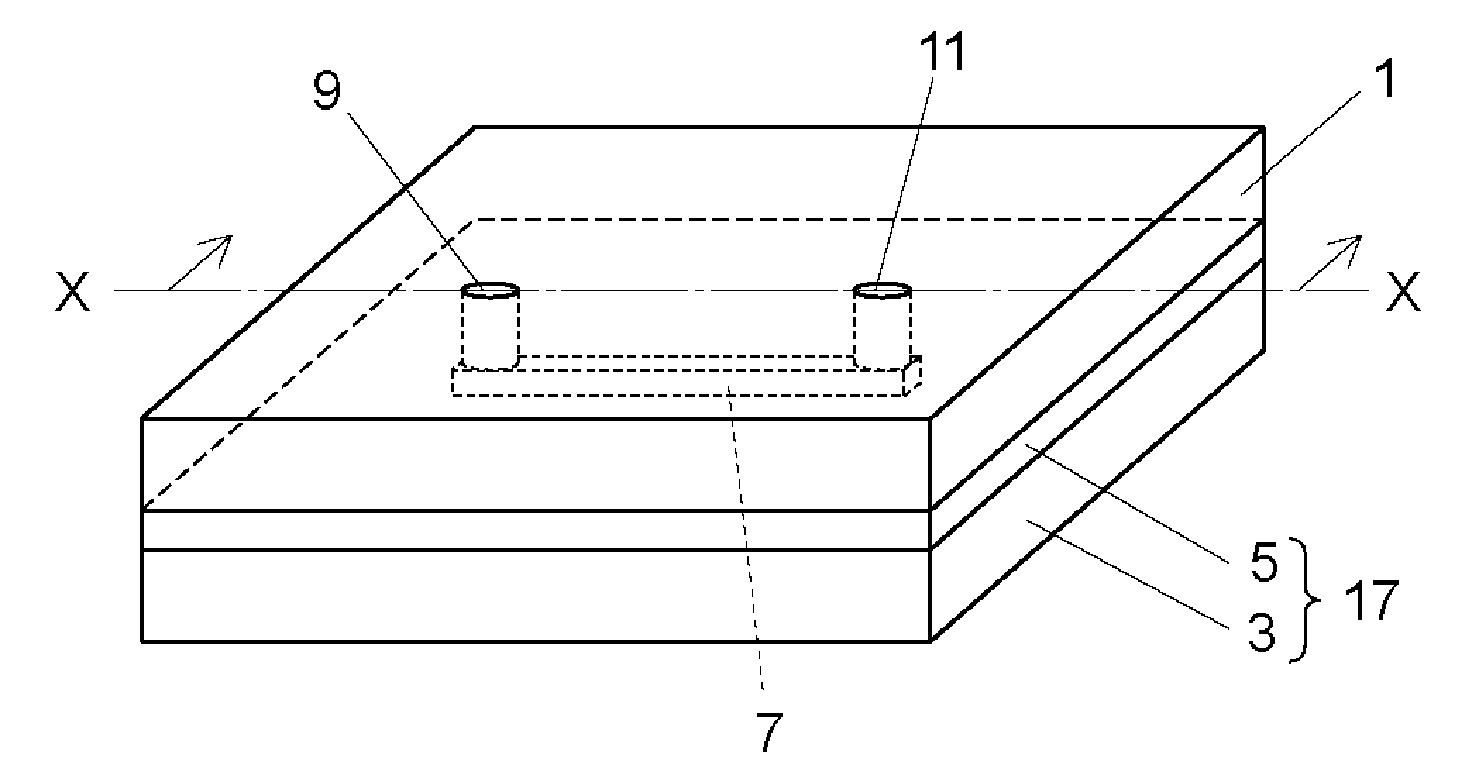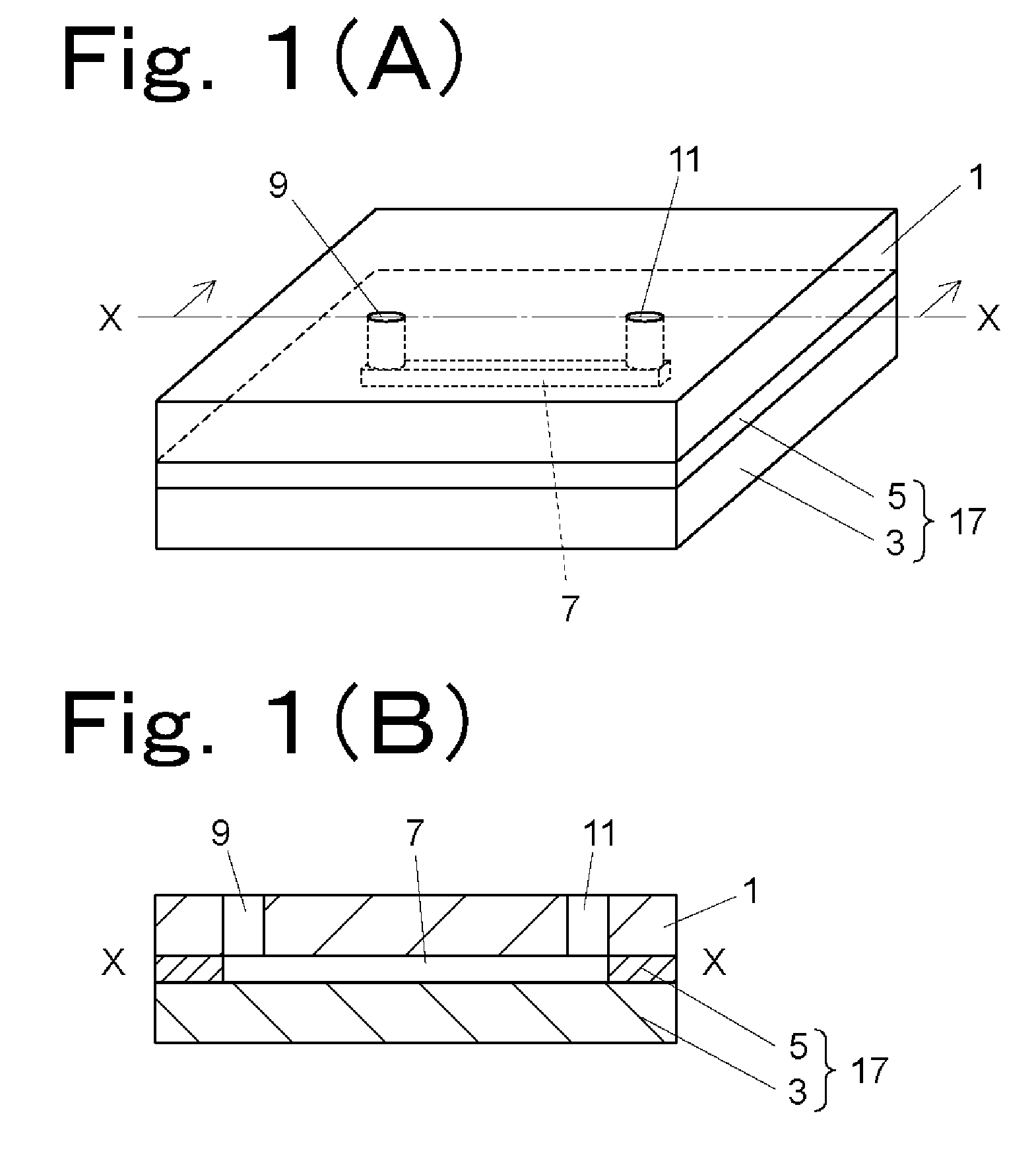Flow cell and process for producing the same
a flow cell and flow cell technology, applied in the field of flow cells, can solve the problems of high production cost, limited use of conventional flow cells, poor resistance of resins to organic solvents, etc., and achieve the effects of reducing the size of the flow cell, preventing the formation of a gap and leakage of solvents, and increasing the bonding strength between these members
- Summary
- Abstract
- Description
- Claims
- Application Information
AI Technical Summary
Benefits of technology
Problems solved by technology
Method used
Image
Examples
first embodiment
[0035]The flow cell includes a plate-shaped glass substrate 3, an adhesive fluorocarbon resin sheet 5 having a groove as a flow path 7 formed by cutting, and a glass substrate 1 as a cover member having through holes 9 and 11 as a fluid inlet and a fluid outlet formed at positions corresponding to both ends of the groove. The fluorocarbon resin sheet 5 is interposed between the glass substrates 1 and 3, and the fluorocarbon resin sheet 5 itself bonds the glass substrate 1 and the glass substrate 3 together. The glass substrate 3 and the fluorocarbon resin sheet 5 bonded to the glass substrate 3 constitute a flow path member 17.
[0036]The fluorocarbon resin sheet 5 is formed using Neoflon™ EFEP RP-4020, and therefore has a melting point of 155 to 170° C. and a decomposition temperature of 355° C.
[0037]FIG. 2 is a diagram showing the process of producing a flow cell according to the first embodiment, wherein FIG. 2(A1) shows exploded plan views of members constituting the flow cell ac...
second embodiment
[0042]Hereinbelow, a flow cell according to another embodiment (a second embodiment) of the present invention will be described with reference to FIG. 3. FIG. 3(A) is a perspective view of a flow cell according to another embodiment (a second embodiment) of the present invention, and FIG. 3(B) is a sectional view taken along the X-X line in FIG. 3(A).
[0043]The flow cell according to the second embodiment includes: a fluorocarbon resin body 27 entirely made of an adhesive fluorocarbon resin and having a groove as a flow path 7 formed in the surface thereof; and a glass substrate 1 as a cover member provided to cover the groove of the fluorocarbon resin body 27. The flow cell according to the second embodiment is obtained by bonding the fluorocarbon resin body 27 and the glass substrate 1 together by means of adhesiveness of the adhesive fluorocarbon resin. The glass substrate 1 has through holes 9 and 11 formed at positions corresponding to both ends of the groove as a flow path 7, a...
third embodiment
[0052]Hereinbelow, a flow cell according to yet another embodiment (a third embodiment) of the present invention will be described.
[0053]As described above, the flow cell according to the first embodiment or the second embodiment is obtained by laminating the adhesive fluorocarbon resin sheet 5 on the glass substrate 3, or by laminating the glass substrate 1 on the fluorocarbon resin body 27 so that one end of the flow path 7 is aligned with the through hole 9 and the other end of the flow path 7 is aligned with the through hole 11. The flow cell according to the third embodiment has a metal film, such as platinum, formed by, for example, sputtering on the glass substrate 1 or the glass substrate 3 to further improve adhesion between the glass substrate and the fluorocarbon resin sheet 5 or between the glass substrate and the fluorocarbon resin body 27. By providing such a metal film on the surface of the glass substrate to be bonded to the fluorocarbon resin sheet 5 or the fluoroca...
PUM
| Property | Measurement | Unit |
|---|---|---|
| decomposition temperature | aaaaa | aaaaa |
| melting point | aaaaa | aaaaa |
| melting point | aaaaa | aaaaa |
Abstract
Description
Claims
Application Information
 Login to View More
Login to View More - R&D
- Intellectual Property
- Life Sciences
- Materials
- Tech Scout
- Unparalleled Data Quality
- Higher Quality Content
- 60% Fewer Hallucinations
Browse by: Latest US Patents, China's latest patents, Technical Efficacy Thesaurus, Application Domain, Technology Topic, Popular Technical Reports.
© 2025 PatSnap. All rights reserved.Legal|Privacy policy|Modern Slavery Act Transparency Statement|Sitemap|About US| Contact US: help@patsnap.com



